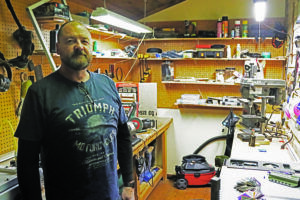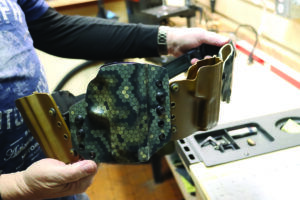
by John Dowd
Arguably as important as good safety ethics with firearms, a responsible user often pairs each pistol with a holster. A holster is like a sling for a rifle, or a cap for a pen. Holstering a firearm helps free a person’s hands to perform administrative tasks. It also makes the firearm safe, protecting the trigger and much more. According to Mark Kathrein, there are three things a good holster should do, including improving safety, as stated above. He should know, because among many things, he owns and operates CKM Holsters, out of Lolo.
Kathrein makes Kydex holsters. These are made out of a special thermoplastic, known as Kydex, which when heated, can be molded and shaped to fit nearly anything. The material is extremely durable, and unlike leather, is virtually unhindered by humidity, sunlight and wear. Kydex holsters can be made to be worn on the hip, like a traditional holster, or designed to be concealed, worn on the chest or in nearly any way a person can imagine. They also come in a plethora of different colors, patterns and designs.

Kathrein got interested in holsters while participating in Practical Pistol shooting competitions many years ago. He was involved with Big Sky Practical Pistol, in Missoula. The group is affiliated with, and recognized by, the United States Practice Pistol Shooting Association (USPSA). This national organization is the governing body that defines the sport, and is often used as a way for military, law enforcement and civilians to practice their shooting proficiency.
Some drills used in USPSA require the ability to fire “weak-handed.” This means they often need to be able to shoot with their non-dominant hand. “I wanted to do an entire season with weak-hand to get better,” said Kathrein. In the process, he needed a left handed holster, but was unable to find one that he could get quickly enough, or that was of acceptable quality, so he started watching videos online and learned to make his own. After finding out that the process was relatively straightforward, he made a number of holsters, which garnered the recognition of his friends and family.
What he was making was of good quality, and looked good, so they began asking him to make them holsters. After getting numerous requests for holsters, he decided to start a business.
“It’s a big market, I don’t expect to get rich,” said Kathrein, talking about the vast competition already selling holsters. Along with his holster business, he is also a truck driver and owns an auto repair business, so he stays busy.
Kathrein has been making holsters since 2016, and has been carrying concealed weapons for nearly 30 years. He has fired hundreds of thousands of rounds, participated in many hours of professional training and has worked with professionals in law enforcement and military through USPSA. “I know how a concealed carry holster needs to feel and how it works,” said Kathrein, with pride in the utility of his product.
According to Kathrein, a holster must be able to do three things, or it can be ineffective and dangerous. First, it must “retain the weapon.” This means it must hold the weapon where it can be retrieved. Secondly, a good holster must allow the weapon to be removed only when the user wants it to be. Finally, a good holster must completely enclose the trigger. A good holster must not allow anything to get inside the trigger well and to cause a negligent discharge.
These things, for Kathrein, are what go into his credo: “My holster can’t be what gets you killed.” For him, it is a big deal. He puts the safety of his customers above all else, and says, otherwise, “why even make holsters at all?”
Whether his products are purchased by hunters and hikers in the backcountry, or by a single mom coming home from work, Kathrein explained that his holsters need to work. “Chances of you or me needing to pull our weapons are very low, and it’s the last thing we want to do, but when you need to draw, you need it now!” Kathrein expressed that a responsible gun owner should do everything to avoid any conflict, as the stakes can be very high. However, when the decision is made to defend one’s life with force, any hesitation or moment lost to a firearm getting caught in the holster can lead to the death of the user.
“I know I turn out a good product,” said Kathrein. He also puts precedent on the customer liking the product. “It’s got to be what you like,” said Kathrein. His main market at the moment is custom work, creating custom made and fitted holsters and rigs for people from all walks of life. “I’m amazed by the people that come to me. People that you would never think would carry a gun,” said Kathrein.
He says he loves meeting people and helping them protect themselves and their families. He has made holsters for law enforcement, patrol officers, ATF and many civilians. Along with meeting people, he loves the challenge of creating new and interesting products to help meet people where they are and provide what they need. He told a story of how he made a holster for a gentleman in a wheelchair. It was a challenge, and he had to reach out to another much bigger holster company for advice, though they had never done anything like that either. “That’s the thing about the Kydex Industry, nobody really patents anything. Everybody helps everyone. It’s kind of open source, in a way,” said Kathrein.
Kathrein is expanding the business soon. He has an extra bay in his auto repair shop and his mechanic wants to buy into the business and help make products. This means they will be able to create a few standard holsters that fit standard firearm models, as well as eventually creating other products. Though he has made Kydex knife holsters, he said that it’s difficult to get proper retention. However, they plan to produce things like tourniquet and Narcan holders for law enforcement, among other things.
The standard holsters will allow customers to order right off the CKM Holsters website and get products shipped to them right away. Right now, customers can reach out and ask for more product information. Kathrein currently charges very competitive prices, asking around $75 for light-bearing, single-piece “taco” style holsters and $65 for non-light bearing “taco” style holders. For two-piece holsters of similar ilk, he charges around $10 more, respectively. Different colors and patterns also add to the cost, as can the hardware if it is unusual or expensive.
Kathrein plans to expand within the year, and update his website. E-commerce capability will be built into his current website, and will allow customers to pay right on the site, and view examples of his products.
Interested parties can visit Kathrein’s website, ckmholsters.com. They can also call him at (406) 240-2318, or email him at lolokydex@gmail.com. However, he says currently the easiest way to reach him is by phone.